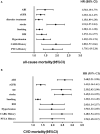Serum Uric Acid Revealed a U-Shaped Relationship With All-Cause Mortality and Cardiovascular Mortality in High Atherosclerosis Risk Patients: The ASSURE Study
- PMID: 34109223
- PMCID: PMC8180559
- DOI: 10.3389/fcvm.2021.641513
Serum Uric Acid Revealed a U-Shaped Relationship With All-Cause Mortality and Cardiovascular Mortality in High Atherosclerosis Risk Patients: The ASSURE Study
Abstract
Background: Previous studies have demonstrated an association between hyperuricemia and cardiovascular disease (CVD). The Framingham study confirmed that patients with high atherosclerotic risks (HARs) had worse prognoses. However, after adjusting for confounding factors, the association between serum uric acid (SUA) and all-cause mortality and cardiovascular mortality remains unclear, especially for HAR patients. Objective: The aim of this study was to reveal the relationship of SUA with all-cause and cardiovascular mortality in HAR patients. Methods: This multicenter cohort study enrolled 3,047 participants, and the follow-up was 68.85 ± 11.37 months. Factors related to cardiovascular and all-cause mortality were tested by multivariate Cox regression analysis. Restricted cubic splines (RCSs) with knots were used to explore the shape of the dose-response relationship with SUA and the hazard ratio (HR) of all-cause and CVD mortality. SUA transformed by RCS was added to the Cox regression model as an independent variable, and all-cause and CVD mortality scores were calculated. Survival receiver operating characteristic curves were produced using a regression model predicting the score. Results: SUA demonstrated a "U-shaped" relationship with all-cause and cardiovascular mortality. SUA predicted all-cause and CVD mortality, with cutoff values of values of >370.5 μmol/L for males and >327.65 μmol/L for females and <180.5 μmol/L for males and <165.7 μmol/L for females, respectively. The survival ROC curve indicated that SUA is able to predict all-cause and CVD mortality, with areas under the curve of 0.702 and 0.711, respectively. The HRs of all-cause mortality (male and female) with hyperuricemia and hypouricemia were 2.08 and 2.01 and 2.04 and 1.98, respectively, and the HRs of CVD mortality (male and female) were 2.09 and 1.79, and 2.02 and 1.89, respectively. Conclusion: Abnormal SUA levels were significant and independent risk factors for all-cause and CVD mortality. Hyperuricemia and hypouricemia increased mortality in both males and females. Routine SUA evaluation and intensive management are needed for HAR patients. Clinical Trial Registration: www.ClinicalTrials.gov, identifier: NCT03616769.
Keywords: all-cause mortality; atherosclerosis risks; cardiovascular mortality; framingham risks; serum uric acid.
Copyright © 2021 Cang, Xu, Zhang, Ju, Chen, Wang, Li and Xu.
Conflict of interest statement
The authors declare that the research was conducted in the absence of any commercial or financial relationships that could be construed as a potential conflict of interest.
Figures






References
Associated data
LinkOut - more resources
Full Text Sources
Medical
Miscellaneous

